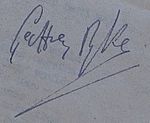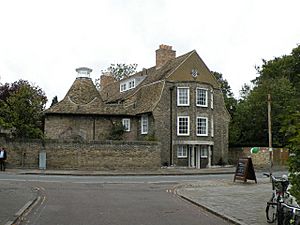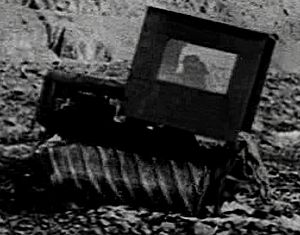Geoffrey Pyke facts for kids
Quick facts for kids
Geoffrey Pyke
|
|
|---|---|
| Born |
Geoffrey Nathaniel Joseph Pyke
9 November 1893 |
| Died | 21 February 1948 (aged 54) Hampstead, London, U.K.
|
| Occupation | Journalist, educationalist and inventor |
| Spouse(s) | Margaret Amy Chubb |
| Known for | Pykrete, Project Habakkuk |
| Scientific career | |
| Fields | Military technology |
| Signature | |
 |
|
Geoffrey Nathaniel Joseph Pyke (born November 9, 1893 – died February 21, 1948) was an English journalist, educator, and inventor.
Pyke became well-known after he escaped from a prison camp in Germany during World War I. He had traveled to Germany using a fake passport and was soon caught.
During World War II, Pyke suggested using a new material called pykrete. He wanted to use it to build a giant ship named Habakkuk.
Contents
Early Life and Education
Geoffrey Pyke's father, Lionel Edward Pyke, was a lawyer. He died when Geoffrey was only five years old. This left his family with no money.
Geoffrey went to a school called Wellington. Later, he studied law at Pembroke College, Cambridge.
World War I Adventures
When World War I began, Pyke stopped his studies. He wanted to be a war correspondent (a reporter who covers wars). He convinced a newspaper editor to send him to Berlin, Germany. He got there using a fake passport.
Pyke spent six days in Germany, talking to people and listening to conversations. He saw Germany getting ready for war. In October 1914, he was arrested and put in a small prison cell.
Life as a Prisoner
Pyke spent time alone in prison. He missed books, writing, and talking to people. When he was allowed outside, he would talk to other prisoners. He also recited poems from memory to himself.
In January 1915, Pyke was moved to different prisons. Finally, he was sent to the Ruhleben internment camp. This was a camp for foreign civilians.
Planning an Escape
At Ruhleben, Pyke met other educated prisoners. They helped him with clothes, food, and books. Pyke became very sick but got better in the summer.
He started thinking about escaping. Most prisoners thought it was impossible. But another Englishman, Edward Falk, agreed to try with him. Pyke studied past escape attempts. He and Falk then exercised to get ready.
The Great Escape
On July 9, 1915, Pyke and Falk hid under tennis nets in a hut. They waited until dark. Then, they climbed over the camp fences.
They took a tram into Berlin, bought new clothes, and camping gear. They traveled west towards the Dutch border. When they were about 80 miles (130 km) away, they decided to walk. They crossed fences and muddy areas.
As they rested near the border, a soldier found them. They tried to talk their way out, but then realized the soldier was Dutch! They had already crossed into the Netherlands. From there, they made their way back to England.
After the Escape
Pyke visited his newspaper editor. He thought his mission had failed. But the editor told him that his escape story was a huge success! Pyke was the first Englishman to get into Germany and escape.
He was asked to write articles about his adventure, but he refused. He was no longer interested in being a war reporter. Instead, he gave talks about his experiences and wrote for a magazine.
Pyke also sent food parcels to his friends still in Ruhleben. He hid details of his escape method in the false bottoms of the boxes. No one else tried his method, though.
In 1916, Pyke wrote a book about his experiences called To Ruhleben – And Back. He left out some details because the war was still happening. The book was republished in 2002. In 1918, Pyke married Margaret Amy Chubb.
Between the World Wars
The Malting House School

After World War I, Pyke tried different ways to make money. He also became very interested in his son David's education. In October 1924, he opened a school for young children in his Cambridge home. It was called the Malting House School.
Pyke wanted a new kind of education. He wanted to encourage children's curiosity. His wife, Margaret, strongly supported the school. Pyke hired a psychologist, Susan Sutherland Isaacs, to run it.
The Malting House School followed the ideas of an American educator named John Dewey. It focused on helping each child grow. Children had a lot of freedom. Teachers watched the children, seeing them as little researchers. For a while, the school was very successful and many educators visited it.
However, Pyke lost all his money in 1927 and went bankrupt. The Malting House School had to close. Margaret Pyke had to get a job. Geoffrey became very sad and lived on money from friends.
Fighting Against Prejudice
In 1934, Pyke spoke out against the rise of anti-Jewish feelings in Nazi Germany. He believed it was important to collect facts and information about people's opinions. His ideas helped start a project called Mass Observation. This project aimed to record the lives of ordinary British people.
Helping Spain in Crisis
During the Spanish civil war, Pyke started an organization called Voluntary Industrial Aid for Spain (VIAS). He encouraged people with little money to give their time and skills instead.
Even though some trade unions were against unpaid work, Pyke kept going. By 1938, his group had sent many vehicles to Spain. These included mobile blood transfusion units. Workers, with help from sympathetic bosses, also made useful items.
Pyke also invented a motorcycle sidecar to carry medical supplies. He raised money for motorcycles and got workers to build the sidecars for free. He also helped get mattresses, old plows, and hand tools for Spain. He even suggested using dried sphagnum moss as a substitute for bandages.
World War II Contributions
Secret Opinion Polls
In 1939, before World War II started, Pyke wanted to know what ordinary German people thought of the Nazi government. He planned to send volunteers to Germany to secretly interview people. The volunteers would pretend to be golfers on a tour. They would ask questions during everyday talks.
Pyke traveled to Frankfurt, Germany, and set up his plan. By August 21, he had ten interviewers working. But on August 25, he called all his agents back to England because war was about to begin. Pyke wrote a report for the War Office.
Military Inventions
Snow Vehicles for Soldiers
When Norway was invaded, Pyke thought about how to move soldiers quickly over snow. He suggested building a special vehicle with screws that would dig into the snow and push it forward. He imagined a small group of fast-moving soldiers could keep many enemy soldiers busy.
At first, his idea was rejected. But in 1941, Louis Mountbatten took over Combined Operations. Mountbatten liked new and unusual ideas. He adopted Pyke's plan, which was called Operation Plough. When he showed it to Prime Minister Winston Churchill, Churchill famously said: "Never in the history of human conflict will so few immobilize so many."
Pyke's snow vehicle idea led to the development of the Weasel tracked vehicle. This vehicle was made in Canada and the United States. Hundreds of these M29 vehicles were built and used in the war.
Project Habakkuk: Ice Ships
In April 1942, Pyke was asked how to stop ships from icing up in cold Arctic waters. He took the problem to Max Perutz, a scientist at Cavendish Laboratory. Perutz suggested a solution.
In September 1942, Pyke sent a long report to Mountbatten. He suggested building huge aircraft carriers out of ice. These ice carriers could launch and land regular fighter planes and bombers. They could provide air cover for ships in the middle of the Atlantic Ocean. They could also be used as bases for long flights or for attacks on enemy shores.
Pyke's idea was not entirely new. A German scientist had suggested ice islands in 1930. Pyke's report was reviewed, and the main ideas were found to be possible. In December 1942, Prime Minister Churchill ordered that research on the project should continue quickly.
The project to build a large aircraft carrier from ice was called Project Habakkuk. Pyke was sent to Canada to work on it. Pyke also thought pykrete could be used for other things. He suggested building landing ships for invasions or quickly building forts on beaches. These ideas relied on his belief in "supercooled water," which he thought could be a weapon. However, these ideas were not practical.
In September 1943, Pyke suggested a smaller plan for pykrete ships. He proposed a pykrete monitor (a type of warship) that was 200 feet (61 m) long and 50 feet (15 m) wide. It would have one large naval gun. He also suggested using pykrete for breakwaters and landing stages. This plan was not used, but for the Allied invasion of Normandy, a system of concrete breakwaters called Mulberry was used instead.
Moving Supplies and People in Pipes
In late 1943, Pyke suggested a new way to unload supplies from ships. This was for places without proper ports or roads. He thought of using pipes, like those used for fuel, to move sealed containers. These containers could hold any small items. He suggested pipes of different sizes, even up to two feet (0.6 m) for larger objects. The pipes could also go inland.
Pyke then thought his "Power-Driven Rivers" idea could be used to move people too. The pipes would need to be at least two feet wide. He even thought about how to give passengers oxygen and help with claustrophobia (fear of small spaces). He suggested people could travel in pairs and use calming medicines.
Pyke believed this system could move people from ships to shore, between islands, through swamps, and over mountains. However, this idea was never used.
After World War II
After World War II, Pyke continued to come up with inventions. One idea for Europe, which was short on energy, was to power railway wagons using human muscle. He thought 20 to 30 men could pedal a special bicycle-like machine to move a train. He believed that Europe had plenty of sugar (for energy) and unemployed people, but not enough coal or oil.
Pyke also worked on problems for the National Health Service. He continued to share his unusual ideas through writing and broadcasting. He spoke out against the death penalty and supported government help for UNICEF.
Death
Geoffrey Pyke died on February 21, 1948, in Hampstead, London. An obituary in The Times newspaper praised him. It said he was "one of the most original if unrecognised figures of the present century."
See also
- Magnus Pyke, his first cousin



